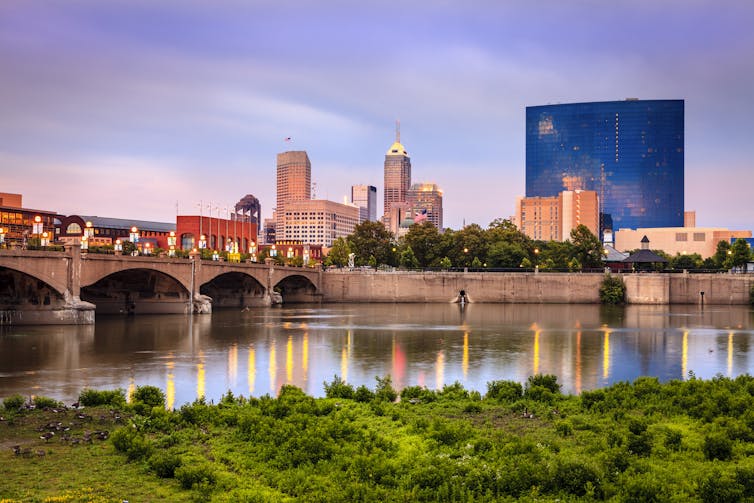Content Warning: The following essay contains mentions of transphobia.
When the intake nurse at University Health Services (UHS) asked my reason for coming in, my heart raced. The person who checked me in that day had referred to me by my legal name — one which I had asked the University to stop using in reference to me at the end of the previous semester (pro tip: changing your name on TigerHub doesn’t change your name in the UHS system). I expected the worst when I blurted out, “Oh, I just had some questions. Um, about gender-affirming care.”
She smiled. “Ah, like a consult?” When I nodded in reply, she took the data and vitals regularly obtained by intake nurses: temperature, blood pressure, any regular medications I was on, etc. When she left the room, I exhaled shakily and held my forehead in my hands. As I waited to be seen by the next practitioner, I thought back through the journey which led me to that room.
Around a year prior, I “came out” to friends as nonbinary on a small social media account. Though the message was framed in a celebratory lens, I cried a bit while writing it. I would keep crying throughout the coming months, as I changed the pronouns I used (twice) and asked my professors to refer to me by a different name.
I was not ashamed of who I was. Still, I was worried about how coming out would affect the way others perceived me. I was raised in an environment where being openly nonbinary was considered unprofessional. I spent several long, lonely nights awake wondering if my peers, employers, and professors would doubt my competency on the basis of my gender expression.
I felt like I had to deal with socially transitioning largely on my own because the COVID-19 pandemic kept me at a distance from large parts of my support network. Changing the pronouns on Zoom, Slack, and Canvas, that I once proudly displayed as a sign of allyship, to ones that acknowledged my transition brought on bullets of sweat. I didn’t know when it was appropriate to correct those who knew of my social transition when they referred to me with gendered terms I didn’t identify with.
No one gave me a roadmap to living authentically, and without one, I felt like I was flying blind, susceptible to so many mistakes along the way.
I wanted so badly to find joy in my social transition. And at times, I did. One day, after a haircut that felt life-changing, I looked in the mirror and felt comfortable with my appearance for maybe the first time. I couldn’t stop smiling.
But at other times, I felt the same way I had felt for much of my life: alien to the way others perceived me. Being referred to with gendered terms that didn’t match my identity took on a new level of pain after having finally admitted to others how I felt inside. Growing up facing expectations around the gender others wanted me to be brought with it panic and anguish — the awfulness of puberty making me look different from my sibling and cousins, the deep discomfort around wearing gendered clothing that I found so hard to explain to my parents. This panic and anguish found new avenues through which to plague me. One moment, I felt joy in expressing who I was. The next, I felt frustrated and confused.
It wasn’t until the summer after I had come out that I was able to settle into my gender expression and learn to navigate the social situations that came with it. I made the conscious choice to be “out” to my employers and the people I was interacting with.
There were moments of embarrassment — awkwardness of trying to insert my pronouns into introductions, a plethora of misgenderings, etc. But they were learning experiences in how to navigate my gender expression in the “real world,” outside of college. I learned patience, graciousness, and honestly, how not to be bothered. My gender identity is a special part of who I am, but at the end of the day, just one small (and beautiful) part.
I learned when it mattered to me to call attention to my gender identity and when it did not. In essence, I learned how to be myself and how to be happy being myself. And then, I really was happier than I had ever been: more confident, more sure of myself, and a whole lot less awkward.
The following fall semester, I found a level of support that I could have only dreamed of previously through actively entering affinity spaces and spending time with an affirming network. The Gender + Sexuality Resource Center’s Gender Group gave me mentors who had been in my shoes and friends who were going through the same challenges. My eating club’s affinity group chat gave me a sense of belonging and no-judgment-camaraderie that I had feared I would no longer have easy access to.
A graduate student mentor of mine generously lent a ridiculously sympathetic ear to me when I first asked her about the prospect of medically transitioning. I had spent years fantasizing about it. From middle school onward, I would spend hours watching Youtube videos of people who had gone through the process and shared their stories. But I was afraid.
The support network that I gained enabled me to finally make the appointment I had spent so long considering. I went into it with so much anxiety. I wasn’t out to my parents, a situation which makes insurance complicated. And I grew up in a religious environment that was generally both anti-gay and anti-trans. (A therapist in high school once told me to consider whether regularly attending church would cure me of my LGBTQ+ feelings.) I had heard more horror narratives of trying to medically transition than positive ones.
When the UHS practitioner finally came into the room where I had been waiting and asked me why I had come in, I started crying. I thought I was about to have to jump through hoops to get the care I wanted — to be diagnosed with “gender dysphoria” or to carefully recount my lifelong struggle with gender. I was afraid I hadn’t been out for long enough to be considered valid or stable, or that a comment would be made about whether my identity was some sort of bandwagoning fad. I hadn’t always had amazing experiences with UHS concerning my regular health problems, and my expectations were low.
None of my fears came to light. I was met with only sympathy, kindness, and a professionalism that I didn’t expect to be granted as a trans person. UHS practices an “informed consent” model of gender-affirming care, which basically means that a practitioner will carefully explain to you the effects of hormone therapy, and if you still want to go through with it, they’ll help you embark upon the process.
After spending a generous amount of time explaining to me what it’s like to be on Hormone Replacement Therapy (HRT) in a friendly manner, my practitioner ordered blood work for me, and after everything came back in order, sent the necessary prescriptions to the local CVS. I found the prescription remarkably affordable without insurance. And I found it insanely relieving that my practitioner had both extensive clinical experience with patients on HRT and personal experience with the process. All my nervous questions were answered with gentleness.
When I filled the prescription, I came back into UHS, and the same practitioner I initially saw coached me on how to self-administer the prescribed hormones through injection. I shook a bit from nerves, but I was allowed to take all the time I needed. It wasn’t scary, and it didn’t hurt.
At the time of writing this, I’m a few months on HRT, and I’m the happiest I have ever been with my body. I’ve found that HRT has not confined me to express myself as the gender often associated with the “opposite” of the one I was assigned at birth, but instead has freed me to feel my best no matter what clothing I’m wearing. Physical changes are slow — I purposefully started on a low dose to make sure of this — but welcome. “Second puberty” is awkward at times, but thanks to the advice and support of friends (cis and trans alike), it’s never felt embarrassing. I look in the mirror, and I see myself. That’s a privilege everyone should enjoy.
It’s not that I never have doubts or anxieties. The nice thing is that medical transition can be stopped at any time. Many changes aren’t as permanent as one might think. Stopping medical transition is not a sign of defeat or not being “trans enough.” Everybody should have the right to explore their gender identity and their options for gender expression. Medical transition is just one option.
I’m writing all of this to say that you are the one who gets to write your story. Socially and medically transitioning can be scary. It has been for me. But it’s not as intimidating as you might think, and it’s not impossible.
Transitioning has led me to love myself in ways I never thought I could. Being trans at Princeton — where student groups still invite transphobic speakers and prominent professors are openly anti-trans — is not always easy. But the easy thing, I’ve been told, is not equal to the right thing.
We are so much more powerful when we live openly as ourselves. The person you are inside — just like the person I am inside — is gorgeous, vibrant, and deserving of love. Do right by the person inside you. It’s our job to love those who live authentically as their authentic selves, and I hope we all do it well. Here’s to doing so, together.
Editor’s Note: The ‘Prince’ granted the author of this essay anonymity due to privacy and safety concerns.










